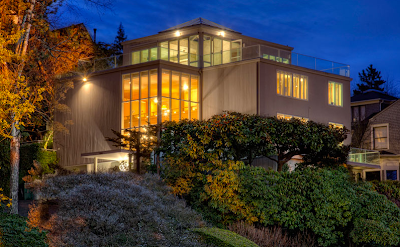A tale of three properties
To a greater extent than many other Seattle neighborhoods, Madison Park enjoys (or suffers from, depending upon your point of view) a lot of churning of its housing stock each year. At any given moment there are usually several homes being pulled down, torn apart, or otherwise rehabilitated. And while the rhythm of this ongoing neighborhood transformation accelerates or slows in keeping with overall market conditions, the cycle of destruction, renovation, and renewal is pretty much a constant in Madison Park—and has been for many years.
One of the reasons for this trend has been the increasing value of Madison Park land. Given that many neighborhood parcels have relatively tiny houses sitting on them, buyers are logically reluctant to maintain what is an anomalous condition: high-cost land with a low-value structure. The goal of achieving a property’s “highest and best use” comes into play in these situations as speculative builders and private buyers alike choose to demolish what exists in order to create large, modern, livable homes.
The house above, a new listing at 2338 41st Avenue E., in the area north of E. Madison Street, is a case in point. A 1941 bungalow of about 1,000 sq. ft. had graced the property when a speculative builder purchased it in 2008:
Development was delayed for several years; but ultimately, Chaffey Building Group this year completed a five-bedroom, 3,750 sq. ft. house on the property, designed to appeal to today’s upscale buyer. Priced at $1,750,000, the new house definitely has the amenities, interior space and visual appeal that its predecessor so clearly lacked.
But what if the little house that’s for sale on an expensive Madison Park property is considered a classic? Though a speculative builder would almost certainly knock such a structure down and start over, a private buyer’s idea of “highest and best use” might be something entirely different: preserve and enhance. A Washington Park house, located at 1212 41st Avenue E. represents a fairly recent case in point:
Another classic home, which is currently on the market, potentially poses a bigger test between preservation and destruction. This 5,100 sq. ft. “Roland Terry masterpiece” sits on a fabulous 7,800 sq. ft. view property across from the Seattle Tennis Club (1101 McGilvra Boulevard).
Built in 1954 and added onto in later years, it was a local precursor of the “contemporary style” of the angular/boxy structures that are now quite the thing with certain developers of Madison Park properties.
Roland Terry has such an exalted reputation that you might assume the buyer of this particular property would automatically rehabilitate and preserve it for posterity. But even given the house’s $3,350,000 listing price, demolition or a complete gutting of the structure are possibilities that have apparently been broached by certain potential buyers who’ve toured the home. However horrifying such an outcome might be to those who value the past, the wrecking ball as an agent of “progress” is only too familiar in other area neighborhoods (just ask the folks in Medina), and it could certainly happen here.
We’ll be watching this one closely.
[Correction: In earlier posting we identified the spec house cited above as being a Chaffey Homes project. The builder, Chaffey Building Group is, in fact, a different legal entity, though with certain principals and employees of the predecessor company in lead roles.]
Photo credits: Top photo courtesy of Bob Bennion, Windermere Real Estate. Cottage photo courtesy of the King County Assessor. Ralph Anderson bungalow photo courtesy of Thomas Jacobson Construction. Roland Terry home photos courtesy of Chris Sudore, Coldwell Banker Bain.






To your point, what is interesting is the dichotomy with the old "Canterbury" section of Madison Park, with its large lot sizes and relatively more valuable structures, even the older ones. In recent years there have been very few teardowns. There have been a few down-to-the-studs remodels (e.g. one going on right now on E McGivlra) but you don't see the teardowns you see in the smaller lot area of Madison Park. My guess is the Canterbury homes are more salvageable and architecturally interesting, so a remodel, even down to the shell, makes more sense, whereas the homes in Madison Park (e.g. the Chaffey home you mention) just don't make sense to salvage, they are truly dumps.
ReplyDeleteI highly doubt the Roland Terry house will be gutted or torn down, there is no way that plot of land is worth $3.35M+. Talk is cheap.
As an owner of Madison Park properties since 1935 as well as someone who fell overboard from the family boat at the location of the present Swingset Park, when it was a part of Fisher's Marina in 1937, but was obviously rescued, I would like to ask. What is the point of your commentary? Oh, I am also a spec. builder, primarily on the Eastside.
ReplyDeleteWell, I guess the point is that depending on your outlook, and perhaps the money available to you, you can either preserve or destroy when you buy a property. Here we have two different examples of what people did recently with existing properties, and one example of a property where the outcome is unknown.
DeleteAre you also a WW1 vet? You would be the right age.
ReplyDelete